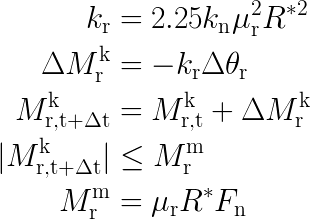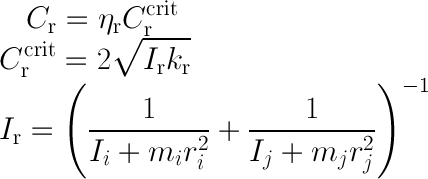
Syntax:
rolling_friction epsd
Description:
This model can be used as part of pair gran and fix wall/gran
The elastic-plastic spring-dashpot (EPSD) model (see Ai et al.) adds an additional torque contribution, equal to

where the torque due to the spring M_rk is calculated as

Here k_r denotes the rolling stiffness that depends on the stiffness of the normal spring (from the normal contact law), the effective radius and the coefficient of rolling friction (mu_r). Following (Ai) the prefactor of 2.25 is valid for 3D simulations. The EPSD3 model allows to modify the prefactor. dtheta_r is the incremental relative rotation between the particles. The spring torque is limited by the full mobilisation torque M_rm that is determined by the normal force F_n and the coefficient of rolling friction (mu_r) (compare the CDT model).
The viscous damping torque M_rd is implemented as

where in the current implementation the damping is disabled in case of full mobilisation (f = 0). The damping coefficient C_r may be expressed as:

Here I_i/j is the moment of inertia and m_i/j is the mass of the particles i and j, respectively.
The coefficient of rolling friction (mu_r) must be defined as
fix id all property/global coefficientRollingFriction peratomtypepair n_atomtypes value_11 value_12 .. value_21 value_22 .. .
(value_ij=value for the coefficient of rolling friction between atom type i and j; n_atomtypes is the number of atom types you want to use in your simulation)
This coefficient mu_r is equal to the mu_r as defined in the CDT model. In addition to mu_r, eta_r is the required material property that must be defined as
fix id all property/global coefficientRollingViscousDamping peratomtypepair n_atomtypes value_11 value_12 .. value_21 value_22 .. .
(value_ij=value for the coefficient of rolling friction between atom type i and j; n_atomtypes is the number of atom types you want to use in your simulation)
IMPORTANT NOTE: You have to use atom styles beginning from 1, e.g. 1,2,3,...
(Ai) Jun Ai, Jian-Fei Chen, J. Michael Rotter, Jin Y. Ooi, Powder Technology, 206 (3), p 269-282 (2011).